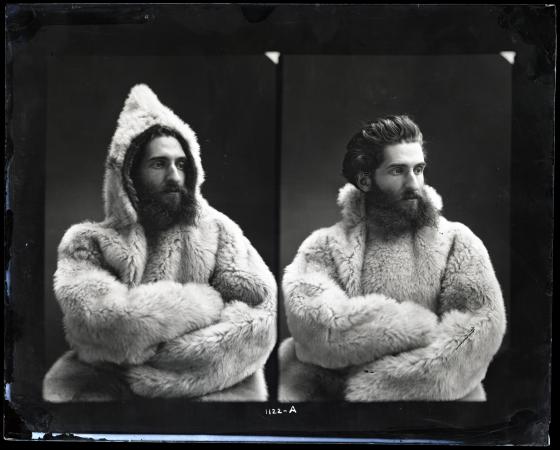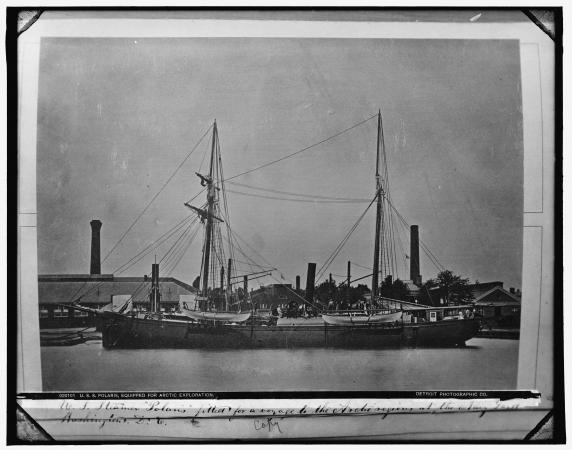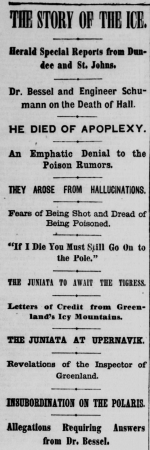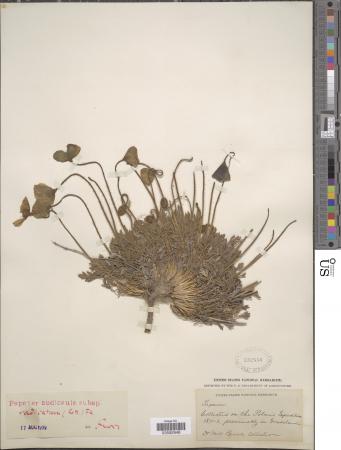In June, we wrote a blog post celebrating how one of our Facebook followers helped us to identify our most popular “unidentified male” as German naturalist Emil Bessels. The mystery was solved and we closed the book on the story forever. No. What really happened was that we learned some of his contemporaries accused Bessels of murdering his commander during a nineteenth-century expedition. Join us down the rabbit hole, won't you?

Bessels was just 24 years old when he set sail on the ill-fated Polaris expedition to the Arctic from the United States on July 3, 1871. Despite his young age, Bessels had already established a glowing reputation for himself. At 18, he became the youngest doctor, at that time in 1865, to ever graduate from the Ruprecht Karl University of Heidelberg. Bessels had also already explored the Arctic during an 1869 expedition to investigate the island of Spitsbegren and served as a military surgeon during the Franco-Prussian War.
These experiences led Bessels to the Polaris as the expedition’s surgeon and chief of the scientific staff under the command of explorer Charles Francis Hall. The expedition, funded by Congress, was led by the United States Navy Department and the National Academy of Sciences, of which Smithsonian Secretary Joseph Henry was president. Henry was particularly interested in the crew’s meteorological observations as the ship attempted to make its way to the North Pole.

But it wasn’t long into the journey until the Polaris danced with disaster. On October 24, 1871, Captain Hall fell seriously ill. According to an 1873 report by the Navy Department, Hall started the day in good health, but then his “most marked symptoms seem...to have been such as indicated congestion of the brain, accompanied by delirium and partial paralysis of one side.” Bessels attended to the commander, but, following a few hopeful days of recovery, Hall died on November 8, 1871.
The following October, the crew faced yet another catastrophe when 19 of its members were separated and stranded on an ice floe. Days later, Sidney O. Budington, now commander, Bessels, and other senior members of the crew still with the ship, ran the Polaris aground in Greenland. There, the ship was destroyed and the crewmembers were forced to make a home there for the winter. Fortunately, those who had been stranded on the ice floe were rescued in April 1873 and the senior members were recovered that June.
Upon their return, the Navy Department investigated Hall’s sudden death, allegedly from apoplexy, internal bleeding, and cleared Bessels of any wrongdoing as his caretaker, despite swirling rumors. In its report, the Navy concluded:
From personal examination of all the witnesses and from their testimony as given, we reach the unanimous conclusion that the death of Captain Hall resulted naturally from disease, without fault on the part of anyone.
On June 23, 1874, Congress authorized a payment of salary to Hall’s widow, Mercy Ann Hall.
But just because Bessels’ name was officially cleared, did not mean rumors about his culpability were not circulated in the press. A lengthy newspaper article from September 21, 1873 in the New York Herald includes statements from Royal Inspector of North Greenland H. Krarup Smith, who suspected “foul play” after noting the feelings of disrespect toward Hall and instances of insubordination by Budington and Bessels in the early days of their journey. Right there in black and white on page five, Smith was quoted as calling for further investigation. “I think the body of Captain Hall, which, I have no doubt is still in a state of preservation, should be sought after and exhumed.” The following day, the Alexandria Gazette, in a tucked-away paragraph, detailed the denials by Bessels, who claimed that the commander had died of apoplexy and “it was only during the delirium of illness that he manifested great fears of being shot or poisoned.”

Despite the public back-and-forth, Bessels’ denial, and the Navy’s clearance, rumors continued to follow the German naturalist. In 1886, in an unrelated story, various newspapers reported that Bessels’ home was burned to the ground, though the doctor had jumped to safety. In reporting the fire, one particular account from the Semi-Weekly South Kentuckian noted that Bessels “is supposed to know more about the cause of Dr. Hall’s death than he cares to tell.” Thirteen years after the Navy Department ruled that Hall died naturally, Bessels was still apparently under suspicion by some.
Now fast forward to 1968 when Arctic historian Chauncey C. Loomis sought to revisit Hall’s mysterious death. Loomis traveled with a team to Greenland to exhume Hall’s body, still well-preserved due to the cold, to test the former commander’s hair and fingernails. And what they found was high levels of arsenic. However, arsenious acid was commonly found in medical kits, so whether Hall treated himself with the toxic compound, distrusting Bessels to properly look after him, or whether it was administered by Bessels will remain a mystery. In the last decade, historians have discussed and presented evidence for motive, specifically Bessels’ jealousy over the affections of American sculptor Vinnie Ream. Despite all our speculations, we may never know what really happened on the Polaris between October 24 and November 8, 1871.

Following the crew’s return to the United States, Bessels remained at the Smithsonian offices to work on publications from the expedition, resulting in the Scientific Results of the United States Arctic Expedition in 1876.
Related Collections
- Polaris Expedition Records, Record Unit 68, Smithsonian Institution Archives
Related Resources
- “Arctic Arsenic,” by Jake Page, Smithsonian Magazine
- Barr, William. Polaris: The Chief Scientist’s Recollections of the American North Pole Expedition, 1871–73. Calgary: University of Calgary Press, 2016.
- “Emil Bessels,” Encyclopedia Artica 15: Biographies, Dartmouth College Library
- Annual Report of the Secretary of the Navy on the Operations of the Department for the Year 1873, pages 283–294
Produced by the Smithsonian Institution Archives. For copyright questions, please see the Terms of Use.

Leave a Comment